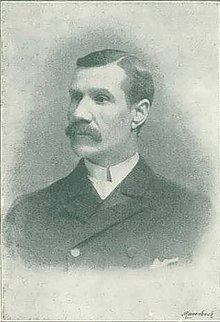| John Littlechild | |
|---|---|
 Detective Chief Inspector John Littlechild in 1893 Detective Chief Inspector John Littlechild in 1893 | |
| Born | John George Littlechild (1848-12-21)December 21, 1848 Royston, Hertfordshire, England |
| Died | January 2, 1923(1923-01-02) (aged 74) London, England |
| Known for | First commander of the London Metropolitan Police Special Irish Branch |
Detective Chief Inspector John George Littlechild (21 December 1848 – 2 January 1923) was the first commander of the London Metropolitan Police Special Irish Branch, renamed Special Branch in 1888.
Littlechild was born in Royston, Hertfordshire. By 1871, he was a Detective Sergeant. He was promoted to Detective Inspector in 1878.
The Special Irish Branch was formed in 1883. It was technically under the command of Detective Chief Inspector Adolphus Williamson, but since he was also responsible for the whole Criminal Investigation Department (CID), Littlechild, as his deputy, was always in effective control. Although he is not thought to have had any direct involvement in the Jack the Ripper investigation, in September 1913 he wrote a letter to journalist G. R. Sims, in which he identified a "Doctor T" (whom he described as "an American quack named Tumblety") as a likely suspect.
Littlechild was promoted to Detective Chief Inspector in 1891. He resigned from the Met in 1893 and worked as a private investigator. He worked for the prosecution in the Oscar Wilde case. In November 1902 he served divorce papers on Arthur Reginald Baker, who days later was murdered by his lover Kitty Byron.
| Police appointments | ||
|---|---|---|
| Preceded byFirst incumbent | Head of Special Branch, Metropolitan Police 1883–1893 |
Succeeded byWilliam Melville |
References
- Emsley, Clive (2017). Emsley, Clive; Shpayer-Makov, Haia (eds.). Police detectives in history, 1750-1950. Aldershot, Hants, England: Ashgate. p. 105. ISBN 978-1-315-24661-1.
- Staniforth, Andrew (2013). Staniforth, Andrew; Sampson, Fraser (eds.). The Routledge Companion to UK Counter-terrorism. Fraser Sampson (1st ed.). Abingdon, Oxon: Routledge. p. 11. ISBN 978-0-415-68585-6.
- Hainsworth, J. J. (2015). Jack the Ripper--Case Solved, 1891. Jefferson, North Carolina: McFarland. p. 172. ISBN 978-0-7864-9676-1.
- Burgan, Michael (2017). Jack the Ripper. New York: Aladdin. p. 187. ISBN 978-1-4814-7944-8.
- Wade, Stephen (2007). Spies in the Empire : Victorian Military Intelligence. London: Anthem Press. p. 199. ISBN 978-1-843-312-62-8.
- Steinmeyer, Jim (2013). "Chapter 13". Who Was Dracula? : Bram Stoker's Trail of Blood. New York: Penguin Publishing Group. ISBN 978-1-101-60277-5.
- Adam, Alison, ed. (2019). Crime and the Construction of Forensic Objectivity from 1850. Alison Adam. Cham: Palgrave Macmillan US. p. 241. ISBN 978-3-030-28837-2.
Notes
- Various contemporary articles in The Times
This United Kingdom law-related biographical article is a stub. You can help Misplaced Pages by expanding it. |